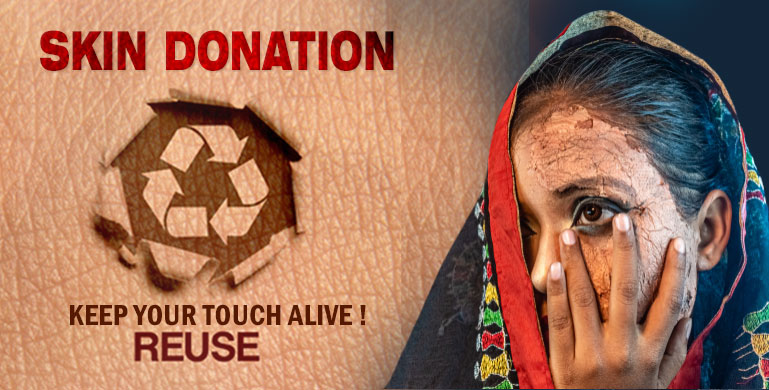Skin Donation, a life-saving act

Dr Nandini Singh Tanwa | Dr Shivangi Saha | Dr Shashank Chauhan
Department of Plastic Reconstructive and Burns Surgery, AIIMS, New Delhi-
Skin is the largest organ of the human body and serves as a protective barrier against infections, regulates body temperature, and retains essential fluids. In patients who have suffered extensive skin loss, these functions are severely compromised, leading to life-threatening complications such as infections, hypothermia, fluid and electrolyte imbalance, and delayed wound healing. Additionally, the exposed nerve endings in damaged areas cause immense pain, while the lack of adequate skin coverage often leads to long-term disabilities, such as contractures, which impair mobility. For such patients, processed skin allografts from donors act as a temporary cover that not only mitigates these risks but also accelerates the healing process, providing a crucial bridge to recovery.
Skin donation is a life-saving act of compassion that offers renewed hope to patients grappling with severe burns, trauma, or extensive skin loss due to various conditions. Despite its life-altering potential, skin donation remains one of the lesser-known and underutilized aspects of organ donation. It involves the harvesting of skin from deceased individuals within six hours of their death or up to 24 hours if the body is stored in a freezer. Donations are taken into consideration in cases of natural death and even in people experiencing multiple organ donations in circumstances of brain-stem death. The skin, once donated, is processed and stored in a skin bank, where it undergoes rigorous testing before being used on patients. The whole process takes around 3 months before it is available for use. Additionally, skin donation can be paired with eye donation.
To ensure the safety and usability of the donated tissue, anyone over the age of 18 who is free of systemic infections, communicable diseases (HIV, hepatitis B & C), venereal diseases, extensive skin conditions, and cancers is eligible to donate skin. The process is conducted under strict medical protocols to ensure safety and respect for the donor’s body. The actual process of skin donation is seamless and involves minimal disruption to the grieving family. Upon notification by the relatives, a team from the skin bank—such as the one at AIIMS, New Delhi—is dispatched to the location of the deceased. The procedure typically lasts between 40 to 60 minutes and involves the removal of a thin layer of skin from non-visible areas like the thighs and legs with very minimal to no bleeding. These areas are carefully dressed post-procedure, ensuring no disfigurement of the body. The donor’s dignity is maintained throughout, and the body is respectfully returned to the family.
Once harvested, the skin is preserved in glycerol and stored in a cold chain at the skin bank. It undergoes thorough testing to ensure it is free from infections and suitable for grafting. Although most of the donated skin is eventually rejected by the recipient’s body, in these precious few weeks it serves its critical purpose as a temporary covering. During this time, the patient’s condition stabilizes, infections are controlled, and the body is better equipped for long-term healing. The use of donated skin significantly decreases pain, improves patient compliance, nutrition, improves survival rates, reduces hospital stays, and helps patients regain their quality of life.
AIIMS, New Delhi, has been at the forefront of promoting skin donation, initiating programs to raise awareness and facilitate the process. The institute has encouraged individuals to pledge their skin, providing easy avenues for registration both online and offline. Upon pledging, donors receive a card confirming their commitment to this noble cause. While there are no monetary incentives, families of donors are presented with appreciation certificates, acknowledging their selflessness and generosity.
Despite its immense benefits, awareness about skin donation remains alarmingly low. Myths and misconceptions, such as fears of disfigurement or concerns about the safety of the procedure, deter many potential donors. Each skin donor has the potential to save multiple lives. The donated skin, once processed, can be used to treat several patients, making it an immensely impactful gesture. By pledging to donate skin, individuals leave behind a legacy of compassion, giving patients a chance to rebuild their lives. As more people come forward to embrace this noble cause, the ripple effects will be felt far and wide, creating a society where empathy and generosity pave the way for recovery and renewal. Let us collectively rise to the occasion, spreading awareness about skin donation and inspiring others to make this selfless gift a part of their legacy, contributing to the advancement of this critical area of medical care throughout our country.

